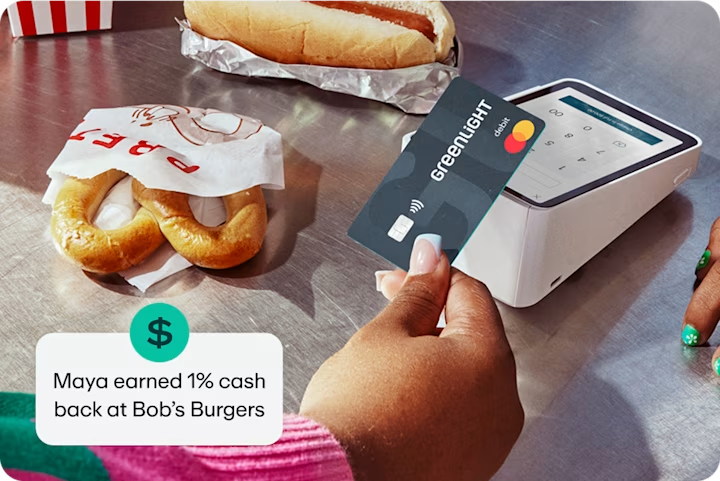
When to use debit vs. credit (and how to teach kids the difference)

Hey, $mart parents 💡
Bring money lessons home with Greenlight’s $mart Parent newsletter, a quick read with impactful tips — delivered free to your inbox weekly.
Key takeaways:
We’ve all stood at the checkout, trying to decide whether to pull out the debit or the credit card. We might think kids aren’t watching, but it’s an easy opportunity to model savvy spending.
Both crebit and debit can be useful in a healthy money routine, but they work very differently. Understanding when to use debit vs. credit can save you money, protect your finances, and teach kids how money really works. Here’s how to know which card fits which situation.
When to use debit
Debit cards use the money that’s already in your checking account, so it’s easier to see how much you have available and keep tabs on the ebb and flow of funds. Here are some scenarios when debit cards may be best:
Daily expenses. Whether it’s groceries, gas, or a coffee run, using debit keeps you on (and within) budget.
When kids or teens are starting to learn about money. Debit cards can be a tool for kids to get hands-on experience managing money. For example, with Greenlight, kids can earn, save, and spend, all within a parent-supervised app.
Budgeting for shared expenses. Debit makes it easier to track real-time spending for things like family groceries or carpool snacks.
Avoid debt. Since you’re using your own money, debit cards don’t charge interest on purchases. They just comes with real-time accountability.
When to use credit
Credit cards borrow money from the bank or financial institution that issued them (see more about how credit cards work). When used thoughtfully, credit can be a great tool. They can make sense in these situations:
You want purchase protection. For travel or big purchases like electronics, credit may provide better safeguards if something goes wrong or gets lost.
You can pay off the full balance monthly. If you don’t, interest charges start to pile up, and that can turn a “deal” into debt pretty fast.
You want to build credit. Credit cards can be a great tool for building credit history, especially for teens or young adults who are new to managing their own money.
You’re tracking rewards. Some credit cards come with different rewards like cash back, bonus points, or travel perks. Just be sure these rewards don’t tempt you to overspend.
Helping kids see the difference between credit and debit
The best way for kids and teens to understand debit vs. credit is to let them experience both in action. Debit card purchases use money they already have from allowance, gifts, or part-time jobs. So you don’t have to worry about debt or racking up interest charges. When they’ve mastered that, you can introduce credit as the next step, and explain how borrowing works and why paying on time matters.
With Greenlight, families can practice money management safely. Kids learn real money skills through their own debit card and in-app lessons, while parents stay in control. When the time comes to talk about credit, they’ll already understand the basics.
FAQs
Should kids use debit or credit first?
Debit is the safest place to start when kids are ready to learn about money management. It teaches them in a hands-on way, without the risk of penalty fees that come with credit cards.
Is it ever bad to use debit?
Even if you have the funds, debit isn’t always ideal for some transactions, like renting cars, hotel stays, or holds that temporarily freeze funds. This is when using credit may make more sense.
How can parents help teens build credit?
When they’re ready, you can add your teens as authorized users on your credit card. It helps them start establishing a healthy credit history early.
What’s the biggest mistake families make with credit?
If you treat credit like extra money instead of a short-term loan, it can cause real financial problems for families. Interest rates tend to be high, so if you don’t pay your credit card balance in full each month, interest charges and late fees add up fast.
Want more money know-how? Meet the Greenlight debit card and app for the next generation. Kickstart a lifetime of financial literacy today. 💰Try Greenlight, one month, risk-free.†
By: Alyssa Andreadis
Alyssa Andreadis is a writer with more than 25 years of marketing experience and is passionate about helping families feel confident with money. She’s written hundreds of articles on personal finance, parenting, and financial literacy. A single mom raising three money-smart teens, Alyssa brings a real-life perspective to her work. She lives in Pennsylvania and always has a knitting project in progress.
Share via
